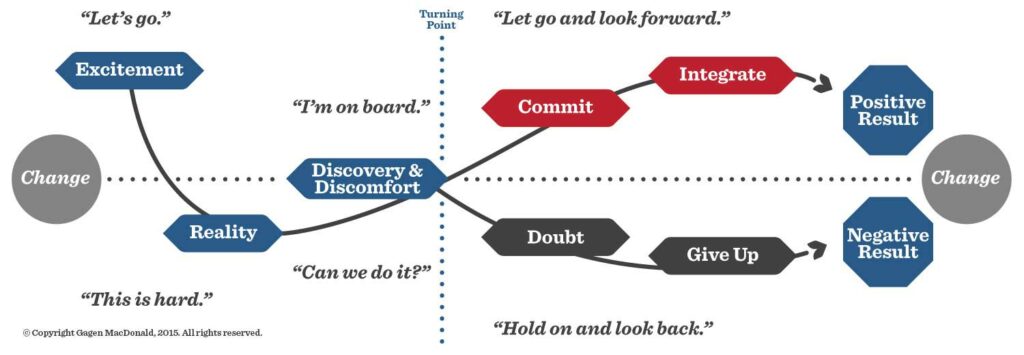In any merger integration, leaders need to immerse themselves fully in three things at once: the transaction at hand, maintaining the daily business, and starting to realize the transformation the M&A deal represents. Put in other terms: while engaged in a heavy lift transactionally, leaders must also keep the business going and inspire a vision for the future. Managing the momentum of change requires incredible skill. M&A leadership requires flexing across a continuum of transaction and transformation, so leaders can create change and inspire employees along the way.
In the beginning of a merger everybody is focused on getting the deal done, and enthusiasm is high. A few months into an M&A integration organizations often hit rough patches--hiccups, where doubt creeps in and people are tempted to give up - or fail to give it the full attention necessary to succeed. We call this process the “change momentum curve”, and it usually looks something like this:

While the entire integration process deserves attention, the red boxes indicate crucial moments where leaders need to make sure all employees stay on board. Here are 5 ways to manage the momentum of change while implementing a merger:
- Plan for the complexity of the challenge. Develop strategies well in advance for addressing conflicts and questions as they come up. The story for change will take time for employees to absorb, too. You want employees to learn to “own” it and convey it in their own words.
- Address “threshold” questions early to help reduce uncertainty. Even if details aren’t known immediately, employees will appreciate an upfront, transparent approach.
- Align and equip leaders for change. We find leadership meetings can be invaluable to communicate the story for change, inspire people to see themselves within the vision, and demonstrate desired behaviors.
- Continually coach the team. Leadership meetings are pretty formal, so you’ll need more intimate meetings to inspire people to see themselves and their daily work in the overall vision. You don’t want to clog up people’s lives with too many meetings, but topping off people’s enthusiasm is important.
- Celebrate incremental successes. People need a lot of reminders about the bigger reasons for doing the deal. Put temporary setbacks into perspective and keep pushing change forward by celebrating incremental progress.
Having an integration plan to manage employee commitment is especially crucial in hostile takeovers. After German-based international chemical company BASF pulled off the largest acquisition in its history, it needed to retain and engage talent in the acquired American firm Engelhard despite significant differences in both culture and organizational size.
Gagen supported BASF’s integration using the 5 tactics outlined above. With a global integration team of 40+ communicators from Gagen MacDonald and both firms, we started by interviewing leaders from both organizations to understand stakeholder perspectives. By sharing those employee insights communally, we gathered the necessary intelligence to create an emotionally compelling, purpose-driven story of change that employees could readily see themselves in and get excited about.
Leadership meetings and numerous “face-to-face” communications strategies kept the lines of dialogue open and deepened employees’ ownership of the change story. A team of 60 BASF integration ambassadors toured the company’s global locations, continually coaching teams at every level of the organization. Finally, the Insight Integration newsletter helped celebrate incremental successes in 12 languages to the entire global workforce.
As our case study outlines, integration planning paid off: BASF successfully retained top talent with 80% of employees reporting they felt well-informed about the changes ahead.
In our experience, successfully acquiring a company is only the beginning. Communicating both immediately and periodically with your employees is crucial to making the merger truly work.
